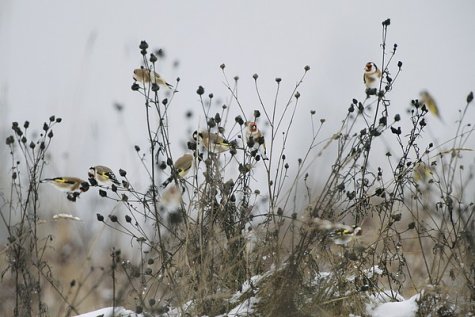Burdocks stick up in the snow
Photo: Arne Ader
Goldfinches
| Goldfinch |
Ohakalind
|
Carduelis carduelis |
The number of goldfinches is larger in summer; there are also many passing migrants but a couple of ten thousand of the beautiful and colourful birds stay in Estonia for the winter.
Goldfinches keep together in groups; they move around and feed in small flocks. Even in snow they manage to find seeds on tall and high-stalked weeds: field thistles, burdocks, mugworts and other composite-flowered plants.
The adult birds are gaily coloured and nearly similar. A legend tells that the goldfinch was late to the colouring of birds when the world was created and was given the remnants of all the colours that had been used for itself.
The plumage on the head is red-black-white, the back is light brown, the wings black with a clearly visible yellow band. The tail feathers are black, with white tips. The beak is rather large and seems specially created to pry out seeds from among the sharp burdock and thistle thorns. The legs are pink-coloured.
The juvenile birds in the flocks are more grey but they too have the characteristic yellow wing band.









